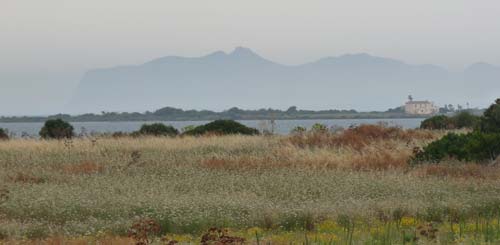Mozia is a memorable archaeological site in western Sicily, between the towns of Trapani and Marsala. The site covers an island, the Isola di San Pantaleo, situated in a striking location in a kind of shallow lagoon lined with the salt flats and windmills that are a characteristic of this coastline and another of its visitable attractions. Out to sea you can glimpse the Egadi Islands. The island’s terrain is flat and rural, and excavated stretches alternate with woodland, vineyard and field. It makes a good day or half-day excursion, with a small museum and extensive ruins to visit.
- Sicily destinations and practicalities: full menu (at foot of this page)
History of Mozia and San Pantaleo
Mozia is also called Mothia, Motya and other variations on the original Phoenician name of the ancient town, which was an important colony of Carthage, the Phoenician-founded city in north Africa. The Carthaginians were crucial in the ancient history of Sicily, building, conquering and losing settlements, generally fighting (though sometimes allied) with the various Greek cities in Sicily. However, it is quite rare and exciting to see such extensive Carthaginian ruins in Italy, and so much evidence of Phoenician culture.
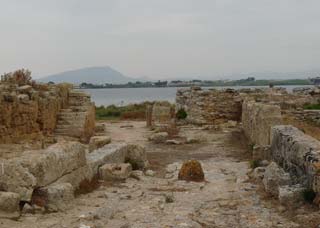
Mozia was destroyed by the Greeks of Syracuse (modern Siracusa) in the fourth century BC, after which the surviving inhabitants developed a new city site on the Sicilian coast nearby, on a headland which was more defensible. The new town was called Lilybaeum, and became the modern town of Marsala. Meanwhile the waters around Mozia , sheltered from the sea by longer islands, silted up into a kind of shallow lagoon. A number of ancient shipwrecks have been found nearby, including Phoenician (Punic) warships which were probably fleeing to the shelter of Lilybaeum after the Romans defeat of the Carthaginians in naval Battle of the Egadi Islands in 241 BC. One of these shipwrecks is on display in Marsala’s archaeological museum.
There was a thriving salt-extraction industry along the mainland shore, but the history of the island, now called San Pantaleo, was just about forgotten when an English exporter of Marsala wine, Joseph Whitaker, bought the land in 1902 and began excavating. It was Whitaker’s enthusiasm which led to the rediscovery of Mozia’s past, and the museum on the island, named after him, is still run by the Fondazione Giuseppe Whitaker.
Visiting Mozia
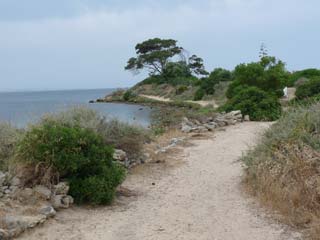
The island is reached by boat (more below) and there is a ticket office by the ferry jetty on Mozia. Admission to the island and museum costs 9 at the time of writing, while a ferry return is 5. Close to the jetty are toilets, a drinking-water tap and some shady benches which are convenient for a picnic. There is also a small cafe on the island with outdoor tables, which serves a limited amount of food such as pastries and pizza slices.
Not all the visitors to Mozia pore over information boards, and study the archaeological remains, trying to piece together the history of the site. Some people just come here for a pleasant day out; the island is an unusual and pleasant place to wander. Children can run around, or play by the lagoon shore. When we visited, we were adopted by an island dog who led us along the footpaths. The island has a perimeter of over a mile, and if you want to explore thoroughly you should allow at least a couple of hours. Wear insect repellent or cover up well; the green landscape amid brackish water is prime mosquito territory.
The museum on Mozia is a good place to begin your tour of the island, since the best finds are here, and it helps give context to the ruins. Some of the museum cabinets display the collection of Joseph Whitaker: small ex-votos, lamps and other bits and pieces grouped together with careful little labels, conjuring up images of that worthy gentleman sitting and carefully sorting and admiring his treasures. A collection of ancient beads are displayed, strung together into a necklace, the label tells us, ‘by Miss Delia Whitaker.’ The museum’s highlights include terracotta masks and funeral stele, some featuring stylised images of women in triangular skirts. The museum’s greatest treasure, though, is a marble statue, the Youth of Mozia (‘Giovanetto di Mozia’), also known as the Charioteer. This is a Greek work dating to the fifth century BC and is a real masterpiece.
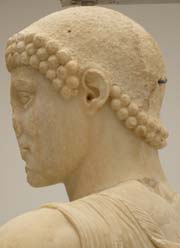
Footpaths lead around the island’s shore and across the interior, past intermittently excavated areas. There is obviously a great deal still to be discovered at Mozia, and excavations are ongoing. Without the free island map and information boards (in English and Italian) it would be hard to make much sense of the sprawling site, but armed with these clues it is a fascinating exercise attempting to envisage the island town as it would have been in its prime. From the various guidebooks and sources it is clear that the meaning of some sites is far from resolved – what was the large water basin by the shore: a harbour or a ritual site? Were there child sacrifices here, or simply infant burials? Mozia is still a rather enigmatic historical site.
Most of the ruins are little more than low walls, but one or two sites are more substantial or evocative: gateways and military buildings, the mysterious water inlet, burial sites and the tophet, a religious sanctuary. The Phoenicians built a causeway to the island, and remarkably this road is still in existence, though now it is just below the water level. The road ran northwards to the mainland, and you can see one end of it through a ruined gateway on the island. A modern Italian guidebook, rather adventurously, suggests that visitors could wade along this route to reach the island (I did not see anyone attempting this and have no idea if it is a feasible or safe possibility).
Salt industry (saline) and windmills
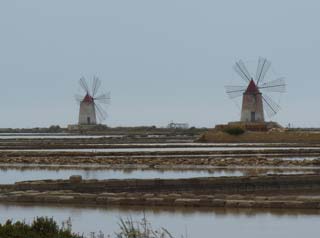
The coastline between Trapani and Marsala is mostly made up of salt pans; strange pale expanses of water and salt, dotted with windmills. There are some of these on the shore by Mozia, so an excursion can effectively combine the two sights. Some of the salt pans are still operative. On the shore closest to Mozia, right by a ferry stop, one of the windmills has been made into a shop and visitor centre, And at the family-run Saline Ettore e Infersa, the site has been opened up as a tourist attraction. You can taste salt, buy salt, buy Modica chocolate with salt and engage in what they call ‘salt tourism’. Take a walking tour through the salt pans, have a go at harvesting the salt, or enjoy an aperitivo with lagoon view. Check dates/times and book ahead. Further up the coast is another small salt tourism attraction, the the Museo del Sale.
Mozia travel and transport
Mozia can be reached by ferries from two spots on the lagoon shore between Marsala and Trapani. Two different boat companies run these services, which head back and forth fairly continuously, apart from a lunch break: Arini e Pugliesi operate the southerly ferry crossing, nearest to Marsala, and Mozia Line run ferries from the more northerly ferry stop, by the Saline Ettore e Infersa complex and the Mamma Caura restaurant. On the mainland there is parking by the ferry jetties. Both companies offer boat excursions and tours of the Isole dello Stagnone, the other islands in this salty lagoon – there is more information on their websites, but I’d suggest contacting them in advance if you’re interested in a tour.
If you are travelling by public transport, the easiest way to get to Mozia is by bus from Marsala. For travellers who are based in Trapani, the best option is to take a train from Trapani to Marsala, and then a bus from Marsala. Although there are two railway stations within possible walking distance of Mozia, there is a considerable amount of road-walking to do, whereas the bus stop is right by the ferry departure point for the island; we got off at the northern ferry crossing, but I believe the bus stopped by both.
The bus for Mozia leaves from Marsala’s bus station in Piazza del Popolo, close to the historical heart of the city, but around 15 minutes’ walk from the railway station. Marsala’s tourist information office on Via XI Maggio had timetables – do check locally in case this bus information is out of date. The number 4 bus is an urban service, and heads north along the coast. Its route varies slightly and the trip can take over half an hour as some services do a big loop before stopping at Mozia on the return leg of the journey. Ask the driver where to get off (our driver was careful to inform us of the return bus times, too). You can buy bus tickets for the outward and return journey at the news-stand inside the bus station building.
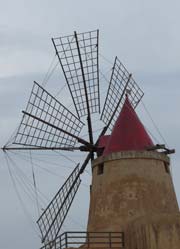
Mozia accommodation
Hotels and B&Bs
If you are travelling with a car, it may be a practical option to stay in the countryside near Mozia. On the coast between Mozia and Marsala is the B&B Al Vecchio Pontile Marsala, which has seaview rooms. The lagoon here is popular with kite surfers, adding to the scenery. The nearest hotel is Hotel Isola di Mozia, which is a practical base. There is also a good choice of holiday rental apartments and villas, and even a hostel in the surrounding area. If you’re relying upon public transport, then Marsala or Trapani are the best places to stay. In Marsala, a good accommodation option is Hotel Carmine, a central 3-star, or the four-star Best Western Hotel Stella D’Italia is also central.
![]()
Highlights
Ancient Sicily – history-themed touring ideas (blog article)
Useful external links
Fondazione Whitaker – Isola di Mozia – Mozia opening times & prices
